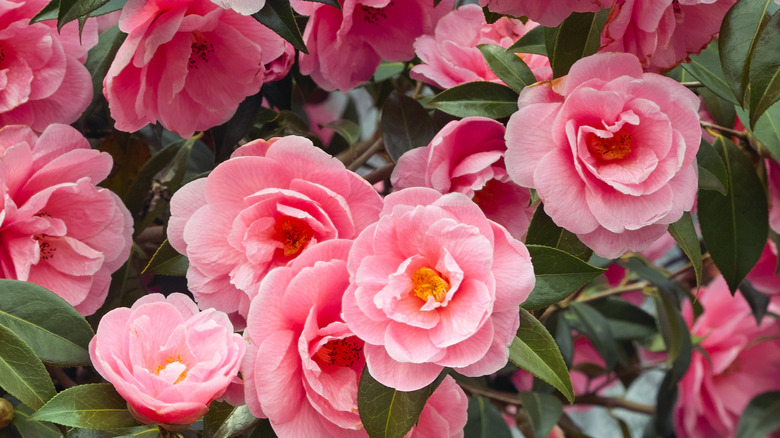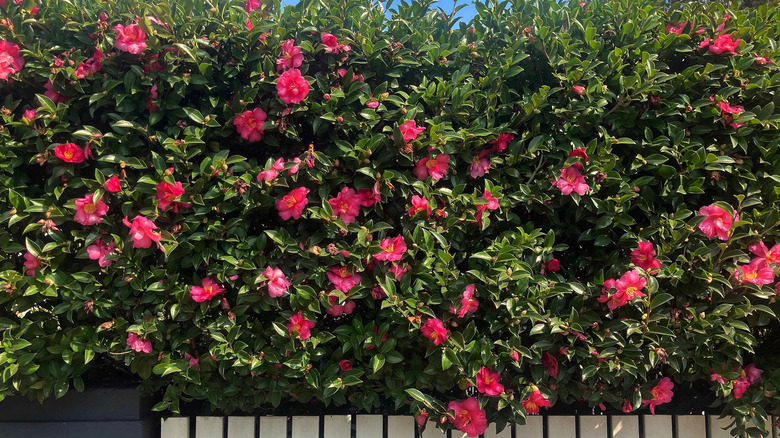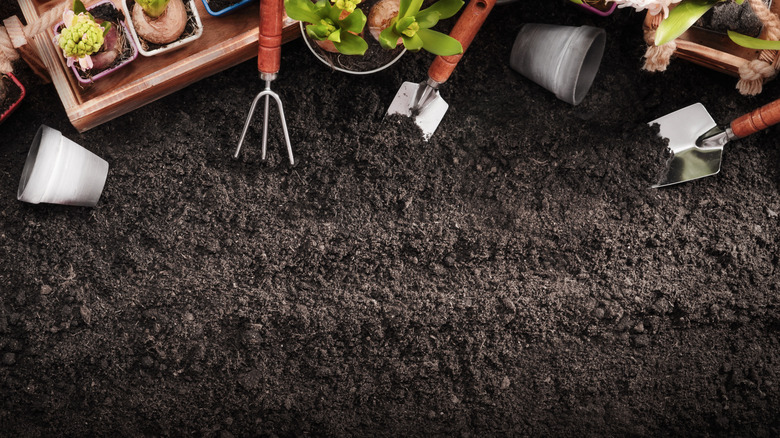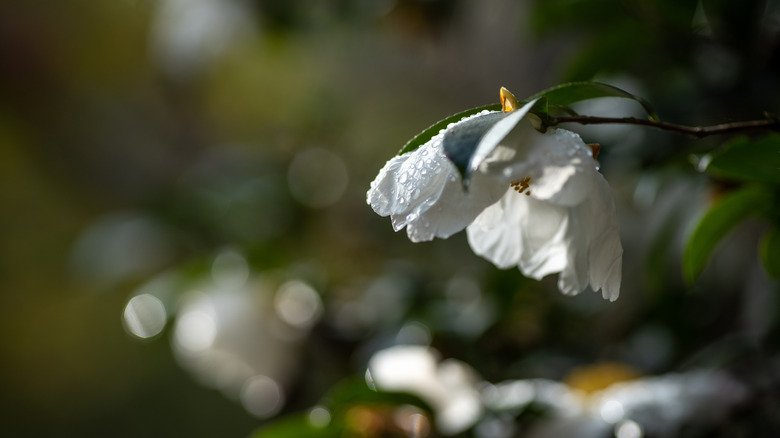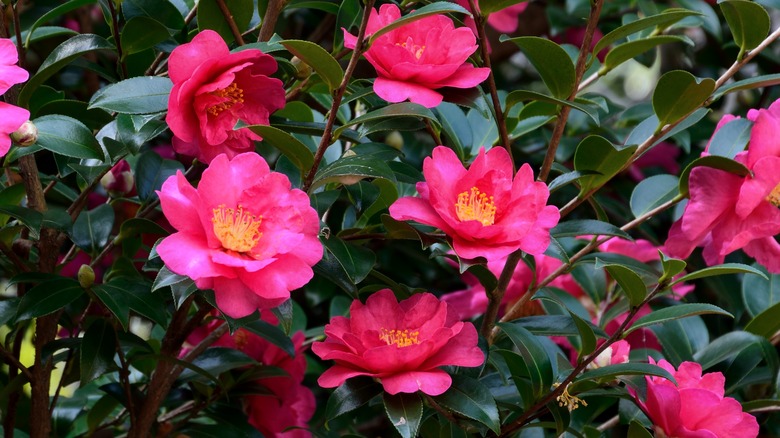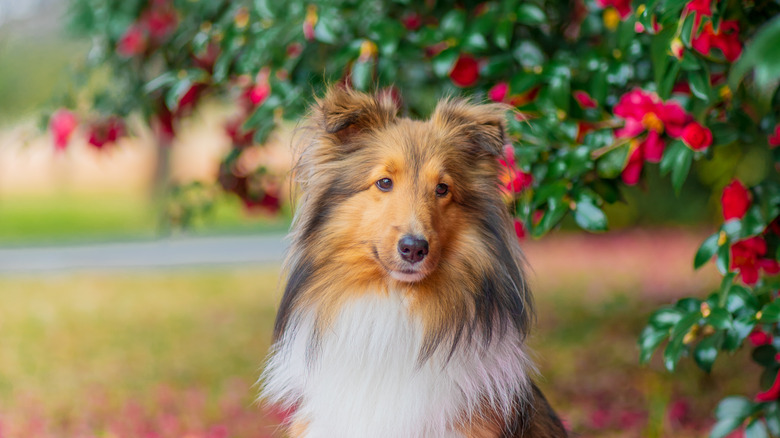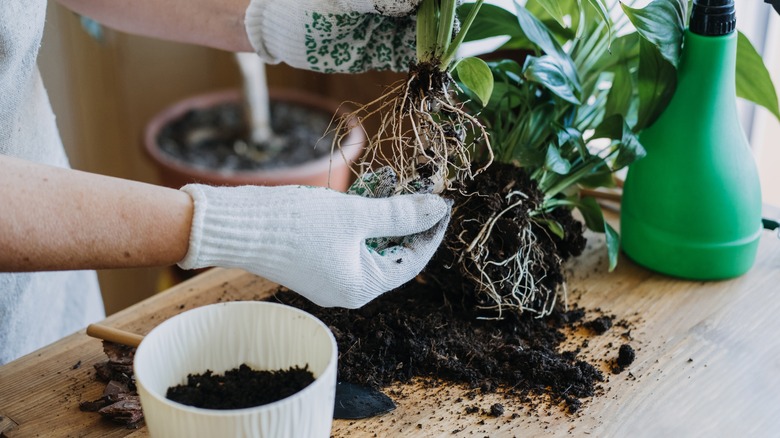How To Grow And Take Care Of Camellia Plants
Camellia plants (Camellia sp.) come from the Theaceae family and have the most stunning foliage that looks like paper mache. They have numerous different-sized round petals that lay on top of one another, creating a soft pillow-like flower. Camellias come in various colors, but the most common colors are pink, red, and white. According to Today's Homeowner, since these flowers grow naturally on shrubs, they can reach 6 to 15 feet tall. Even though they only grow about a foot per year, they're easy to develop and care for.
While you can grow these floral beauties right in your backyard in any part of the world, they are native to the eastern and southern parts of Asia, Southern Living notes. They travel as far as Korea and Vietnam. Furthermore, the American Camellia Society mentions that there are over 300 species of camellias, with the genus Camellia Sinensis being used to make tea for thousands of years. They can be grown as shrubs or small trees, so they're the perfect staple species to plant in your garden.
How to use camellia plants in the garden
Growing camellias in your garden can disguise areas you're not fond of in your outdoor space, such as fences that are run down and haven't been painted in years, Monrovia says. Place them along the side of the house in between pathways so that they grow tall and thick to enclose your home. If you have an open front yard where you can see your neighbor's car every morning, you can plant these shrubs that will grow into 15 to 20 feet tall hedges to give you privacy.
If you prefer to go for more of an ivy look to your home, you can train camellias to grow on walls or along a fence to give the structure some color, especially if you don't have enough space to develop a full shrub. If you'd rather have it as the main focus in your garden, you can also get your camellias to grow as trees by continuously pruning the bottom branches to create a trunk. This way, you'll have a gorgeous camellia tree in full bloom.
How to grow camellia plants
Camellias are simple to plant, but choosing the right location in your garden can be the hardest part since you want an area that isn't too sunny nor too shady, Gardenia advises. They grow best in partial shade areas and shouldn't be exposed to morning or hot afternoon sun. They should be planted in organic, well-draining soils with a pH of 5.5 to 6.5, as per Gardenia. So, to plant your camellias, you'll need your choice of camellia plant, a part shade planting site, compost, moss or ground bark, and well-draining soil.
Once you've chosen where you're going to plant your camellia, dig a hole that's twice the size of the rootball in height and width for the roots to grow comfortably. You want it to fit the same way it was in its initial pot. Pick up the camellia by the rootball and place it in the hole, making sure the top of the rootball is level with the hole's opening. Mix the soil that you dug up with well-draining soil, the peat moss, or compost, and slowly fill the hole with the mixture to the top, then pat down the ground gently. After you've finished packing the soil, water the plant until the ground is moist, and place bark or more moss on top to lock in the moisture. Keep the soil moist by watering it every few days.
How to care for camellia plants
Like most flowers, when you first plant them, camellias will need to be on a watering schedule to keep them moist and encourage growth. Once they are fully grown, they won't need to be watered as much. To start, water two to three times a week, preferably with rainwater, but tap water works just as well, Gardeners' World says. You should also give them to drink well in the summer and fall because that's when they start growing their flower buds. Camellia is a hardy plant, so make sure to cover them with fleece in the winter so they don't lose their buds, per Gardener's World. You always want to make sure they receive partial sun and shade for the perfect growth.
You don't need to prune them in order for them to flower but depending on your vision for the height of your camellias, you can decide to cut back their branches or let them grow out. Because they can grow up to 20 feet as a hedge, as mentioned, you can prune them just a bit to keep their shape and straight clean edges. Or, you can shorten them to keep them as smaller shrubs, less than 10 feet tall.
Camellia plant varieties
There are over 300 varieties and more than 20,000 named camellias that you can grow in your own garden or visit in any botanical garden. They're native to the eastern and southern parts of Asia, according to Plant Addicts, and can confuse people as they resemble rose plants from a distance. However, they have no thorns, so they're perfect for any spot in your home, especially if you have pets. These are some of the most wonderful camellia species per Plant Addicts:
- Japanese Camellia (Camellia japonica) — This species is one of the rare camellias that can be grown up to zone 6, and they can handle colder temperatures than other varieties.
- Sasanqua Camellia (Camellia sasanqua) — Normally grown as smaller shrubs, this variety typically flourishes in Zone 7 and the south. They need partial shade.
- Tea Plant Camellia (Camellia Sinensis) — This variety is amazing for teas and is said to be the first plant that was used to make tea in China.
- Waterlily (Camellia x williamsii) — This is a hybrid of two camellias that create a beautiful dark green shrub with cotton candy pink petaled flowers per XeraPlants.
- Cornish Snow (C. cuspidata × C. saluenensis) — This plant has white flowers that grow on dark green shrubs, which bloom best in the spring per Candide.
Are camellia plants toxic to pets?
Camellias are not toxic to your furry pets, according to SFGate, so if they ingest small amounts of any part of the flowers or leaves, it won't harm them in any way. They could experience some diarrhea or vomiting if they consume too much of the plant, though, but if they have a few nibbles here and there, they'll be just fine. However, if you notice your pet not feeling well after eating a few leaves or flowers, you should visit the vet.
Although the flowers and shrubs aren't harmful to your animal friends, the pesticides that you use on your plants to keep away insects could be detrimental to your animals. They contain toxic ingredients that can make your pets fall ill, so in order to prevent that, remove unwanted insects with water or soap, SFGate recommends. It's always a good idea to look into the pesticides you're using around your animals to make sure they're safe to use.
How to repot camellia plants
If you purchased your camellia as a potted plant, then you'll probably want to transfer it over to a bigger pot for the roots to have more room to grow. Gardeners' World notes that camellias don't need to be repotted very often since they're slow-growing plants, but if you'd rather have them growing in your garden, it's best to transfer them over early in the spring. Some things you'll need for the repotting process are clippers, well-draining soil, and mulch.
To start, dig out the soil from the pot, careful not to break or harm the branches. Once you get as much soil out of the pot and see the rootball, gently pull out the plant holding it by the base of the stem, and set it aside. Add the compost and well-draining soil to your bigger pot, starting with the base and about halfway up from the bottom. Gently place your rootball in the pot making sure it's aligned with the tip of the pot. Fill the rest of the container with the compost and soil until there's a layer at the top. Water the soil until it's moist, and cover it with mulch to keep in the moisture. Water three times a week or as needed to keep the dirt moist.
